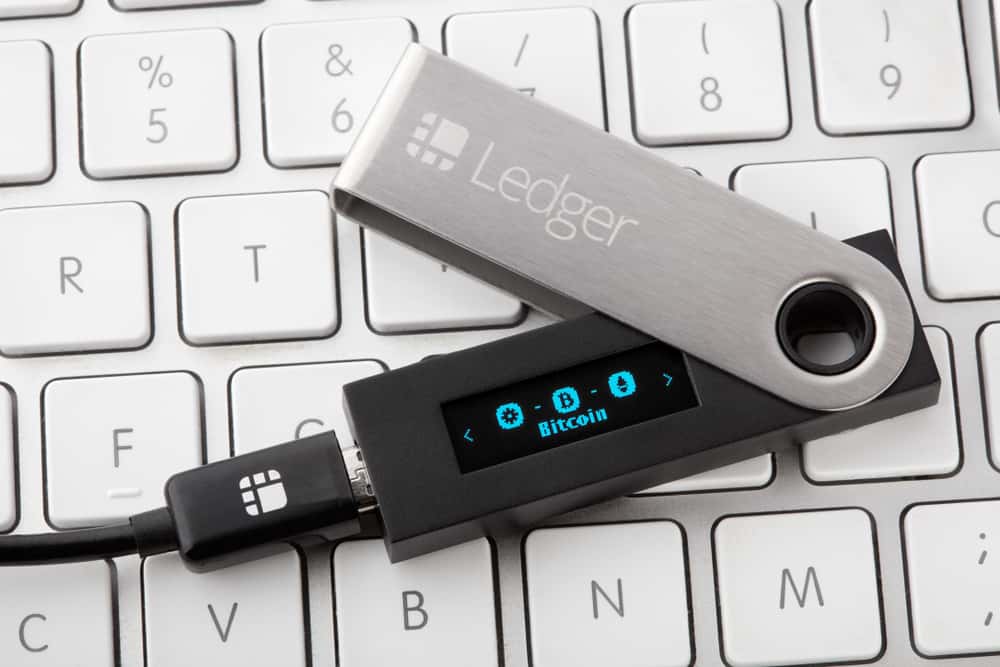There are many different hardware wallets on the market, and choosing the best one can be challenging. But don’t worry—we’re here to assist you.
You can take charge of your cryptocurrency holdings and transactions with the help of a Ledger wallet. Combined with the Ledger Live app, this wallet consolidates the processes of acquiring, exchanging, and storing your cryptocurrency holdings from a single, trustworthy platform.
In this article, we’ve broken down the essentials you need to know and demonstrated why Ledger wallets are the way to go.
What Is Ledger Wallet?
The French startup Ledger has quickly risen to prominence as one of the industry’s go-to providers of cold wallet solutions since 2014.
Ledger devices are highly recommended as cold wallets because of their security for keeping cryptocurrency safe. And if you want to wow your friends and family, they come in various vibrant hues.
Types of Ledger Wallets
The current lineup of Ledger wallets includes Nano X, Nano S Plus, and Nano Stax, all of which can store cryptocurrencies and NFTs.
Every Ledger wallet features a firm metal body in various colors and a compact display.
The premium wallet known as Ledger Nano X is designed to work with desktop computers and, through the use of Bluetooth pairing, can also be linked to smartphones. Because the device only transmits publicly available information over Bluetooth Low Energy, sensitive user data is never sent outside the device itself.
Moreover, you need not worry about a hacker gaining access to your Ledger wallet over Bluetooth because the secure Element (SE) requires your permission before making any changes.
The Nano Stax and Nano X are Ledger’s two most advanced cold storage wallets, allowing users to transact with DeFi and NFTS, respectively. At the same time, the Nano S Plus is the company’s most affordable cold storage wallet, serving as simple crypto asset storage.

- 350+ Cryptocurrencies Listed
- <0.10% Transaction Fees
- 120 million Registered Users
- Secure Asset Fund for Users
- Earn On Deposits

- US Based
- Start with as little as $10
- Buy and sell 200+ cryptocurrencies
- Pro Solution for larger traders
- Available in 190+ countries
How Does a Ledger Wallet Work?
The slender compact Ledgers are similar in appearance to USB sticks and even include small displays that can be pretty useful. You only need a USB cable to sync your Ledger wallet with your smartphone or computer. The latest Nano X models even have Bluetooth connectivity.
The first thing to do with your fancy new Ledger is to sync it up with your computer or smartphone. As soon as you do, the wallet will ask you to set a 4-digit PIN. Remember that you’ll need to provide this PIN each time you use or sync your Ledger wallet.
After selecting a Personal Identification Number (PIN), your Ledger device will provide you with a 24-word recovery phrase. Put this passphrase away someplace secure without Internet access. If you lose your PIN and recovery phrase, you will be permanently locked out of your Ledger account.
You will also be encouraged to download Ledger Live. The Ledger Live app can be accessed on a computer, mobile device, or tablet.
What Is Ledger Live?
When you connect your Ledger wallet to Ledger Live, you gain access to a suite of services and applications designed to function seamlessly. The Ledger Live app provides an encrypted entry point into the blockchain network.
With the help of this app, you can utilize your hardware wallet to quickly and easily gain access to a wide range of crypto, NFT, and DeFi-based services, thereby improving the user experience and avoiding the primary security risk posed by blind signing.
Ledger Wallet Apps
When it comes to your crypto holdings, the apps responsible for managing your assets on your Ledger device are indispensable. By linking your hardware wallet to the Ledger Live app, you will have effortless access to these applications.
The Ledger Live Manager will walk you through the process of installing these on your device. What’s the point of using apps with Ledger Nano X and S, though? Where do they fit into the picture, exactly? Let’s investigate this in more detail.
To begin with, your hardware wallet uses your unique 24-word recovery phrase to generate private keys, which are then used to validate recipient addresses and payments.
To protect your crypto assets, you should always keep a copy of your 24-word recovery phrase in a safe place. A private key is used to manage the associated cryptocurrency address for each user. Although the 24 words allow access to your cryptocurrency accounts, each private key can only do so for a single cryptocurrency asset address.
To ensure your data is as safe as possible, your applications don’t have access to your recovery phrase. Instead, they send a request to have the private keys calculated based on your 24-word phrase and a certain parameter. This parameter is referred to as a derivation path since every cryptocurrency has a one-of-a-kind route that takes it to the wallet.
Once all of the app’s security requirements have been met, the app will receive a response containing the private keys. Actual cryptocurrency ownership consists of owning the private key that unlocks the corresponding digital asset. You are the only person who should have access to this key and are responsible for ensuring its safety at all times.
Ultimately, neither these operations nor transactions will be possible with your private keys, as you don’t need them to verify your transactions and receiving addresses. The Secure Element chip is where all of this action takes place, thus guaranteeing the privacy of the data being processed.
Ledger Wallet Security
One of the best ways to protect your cryptocurrencies and NFTs is to use a Ledger hardware wallet in conjunction with the Ledger Live app. To ensure that your private key is always safe, your hardware wallet stores it in an encrypted chip that has been verified as secure. Except for yourself, no one else can get in there. For any purchase to go through, you’ll need to check it out on the device’s reliable screen and give your physical approval.
The synergy between these two components gives you true ownership gratification. Put another way, the Ledger ecosystem gives you complete control over your finances.
Additionally, Ledger employs a hacking group (Donjon Labs) to test various attack vectors, even though cold wallets are fundamentally secure because they are offline. The hackers even have a blog where you can read about all their attempts to breach the Ledger platform’s security.
Since the hackers typically fail to hack the platform, the Evaluation Assurance Level (EAL) of 5+ for Ledger wallets has been confirmed, making these crypto wallets some of the most secure options available in the industry.
The Ledger Servers Hacking Incident
Unfortunately, the servers run by the company behind the Ledger wallet have been breached. Namely, hackers managed to gain access to Ledger’s servers in July 2020. There were about 272,000 customers whose information was compromised, and almost a million email addresses were exposed.
According to the report from the company, sensitive data was leaked, including first and last names, residential addresses, and other personally identifiable information. Ledger has responded to the cyber assault by bringing on a new Chief Information Security Officer (CISO), performing a cycle of penetration tests, and taking additional steps to shore up its defenses.
Supported Cryptocurrencies
You can use a hot (online) wallet like MetaMask with a Ledger device to gain access to decentralized applications, as Ledger devices are compatible with more than 5,000 different coins and tokens.
More specifically, if you are the type of person who “Holds On for Dear Life” (HODLs) and buys up a lot of small-cap alternative cryptocurrencies before they become popular, then Ledger might be the wallet for you. Namely, the maximum number of coins and tokens that can be stored in a Ledger wallet is 5,500.
Customer Support
Those who feel they could benefit from some instruction can take advantage of Ledger’s extensive learning library, Ledger Academy, which covers not only Ledger but also blockchain technology and cryptocurrency in general.
The sheer size of Ledger’s collection of help pages is impressive. Each piece is informative and easy to read. This is the largest collection of technical Frequently Asked Questions (FAQ) pages I’ve seen on any marketplace. As a bonus, Ledger Academy houses a knowledge repository worth exploring.
The Ledger’s excellent customer service is highlighted by its Live Chat feature, which guarantees a response to your issue within 10 minutes. Although they don’t offer phone assistance, the quantity of help and guidance they provide is still amazing for a cold wallet provider.
Conclusion
The security and intuitive interface of Ledger’s wallets is likely the most important factor in the French company’s success. Everything about it is smooth and easy to use, from the initial setup to the regular syncs, but it’s, above all – safe.
Because Ledger wallets are simple electronic devices, it is impossible to break into one of these wallets using malicious software. They are simplified to an extreme degree and have relatively few valuable functions. They merely take in crypto, keep it, and pass it on.
Therefore, there is a negligible amount of coding to examine, making Ledger virtually impossible for cybercriminals to locate its security flaws. Plus, the wallet saves your crypto in cold (offline) storage.
For this reason, Ledger wallet devices are arguably some of the safest crypto-storing solutions in the industry.
Ledger Wallet User Reviews
Review Summary
Recent Ledger Wallet Reviews
There are no reviews yet. Be the first one to write one.


